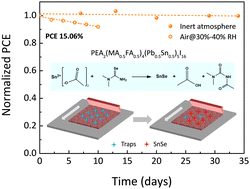In situ SnSe deposition as passivation for scalable and stable quasi-2D lead–tin perovskite solar cells†
Abstract
Lead–tin (Pb–Sn) perovskites are a highly promising composition for single-junction and all-perovskite tandem solar cells due to their narrower bandgap and reduced toxicity. While the use of quasi-two-dimensional (quasi-2D) Ruddlesden–Popper phases has resulted in superior stability towards the environment and large improvement in the crystallization with respect to the 3D compositions, very little work has been done towards their deposition with scalable techniques. Here, PEA2(FA0.5MA0.5)4(Pb0.5Sn0.5)5I16 (n = 5) with a gradient structure is successfully prepared for the first time via a two-step blade coating. Perovskite films which are treated with tin(II) acetate (SnAc2) along with N,N-dimethylselenourea (DMS) exhibit a reduced number of surface traps and enhanced surface crystallization, owing to the in situ formation of tin selenide (SnSe). Record devices with power conversion efficiency (PCE) of 15.06%, an open circuit voltage (VOC) of 0.855 V, and negligible hysteresis are obtained. More importantly, the hydrophobic SnSe significantly protects the active layer from the environment. These devices retain 91% of the original PCE after 10 days in ambient air (30–40% humidity) without encapsulation, and almost no degradation of the PCE is detected after over a month of storage in an inert atmosphere, and under continuous MPP tracking for 15 hours.

- This article is part of the themed collections: Recent Open Access Articles and Celebrating the scientific accomplishments of RSC Fellows


 Please wait while we load your content...
Please wait while we load your content...